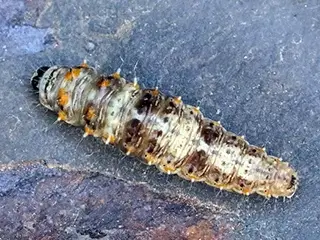Cotton is a major commercial crop in India, but cotton farming often faces the issue of bollworm infestations. Among the pink, American and spotted bollworms, the pink bollworm is known to cause significant problems for the cotton crop. Nonetheless, spotted bollworm attacks can also sometimes lead to the shedding of fruiting points by up to 65-70%.
Let’s learn how to control spotted bollworms in the field, recognise plant symptoms when infested and manage an attack of spotted bollworms.
Let’s Get to Know Spotted Bollworms Better
There are 2 species of spotted bollworms that cause damage to the cotton plant
- Earias vitella
- Earias insulana
Identification of Pests
- Earias vitella:
Larva: Larva appears to be brown in colour with white streaks on the dorsal side whereas pale yellow ventrally.

Adult: Adults are buff coloured with pea green forewing, wedge shaped white band running from base to outer margin

2. Earias insulana
Larva: The larvae are brown in colour with a white longitudinal streak on the dorsal part. The last two thoracic segments and the abdominal segments have tubercles, one lateral and one dorsal.

Pupa: Brown and boat shaped.
Adult: Adults of Earias insulana are small and buff coloured. Forewings are uniformly silvery green.

What Does a Spotted Bollworm Infestation Look Like?
Spotted bollworms mainly feed on bolls. If there are no bolls on the cotton plant, they will feed on squares, shoots and flowers.
Bollworm Symptoms on Cotton Plants in the Vegetative Stage
If bollworms attack the plant in the vegetative stage, they first attack the terminal bud, which leads to the drying and shedding of terminal shoots before flowering. If they attack the main stem, it might lead to the death of the whole plant.
Bollworm Symptoms on Cotton Plants during the Flowering and Boll Development Stages
The larva of spotted bollworms feed on flower buds and bolls. These enter through holes around the base.
Flared squares: One of the important symptoms of spotted bollworms is flared squares in cotton plants where damaged flower buds spread prematurely and this also leads to spoiling of lint.

The damage caused by spotted bollworms can be easily identified by the presence of excrement. This excrement, along with the damage to plant tissues, leads to increased fungal and bacterial infections.
The cotton plant should be taken care of from the very beginning, as when the younger plant is attacked by the spotted bollworm, the damage caused will be more severe.
Therefore, management becomes important.
But how can we keep these spotted bollworms away from cotton plants?
Learn more about the different types of bollworm attacks in cotton here
Management of Cotton Spotted Bollworm
- Biological Control
Nature has its own superheroes to fight bollworms! Here are some key biological control methods:
- Release of Predators and Parasitoids:
Green lacewings and tiny wasps called Trichogramma chilonis love to eat bollworms. Bringing them into your fields can help reduce bollworm numbers without hurting the environment.
- Mechanical Control
Sometimes, simple tools can do wonders. Ploughing the soil before planting and cleaning up after harvest can disturb bollworm homes and stop them from multiplying.
- Mouldboard Ploughing:
Prior to sowing, mouldboard ploughing helps in exposing the resting pupae in the soil to heat and sunlight. This practice helps eliminate bollworm overwintering sites, reducing their population in subsequent seasons.
- Timely Crop Residue Removal:
Remove cotton stubbles after the final picking of the season to eliminate caterpillars and pupae hidden within. Additionally, clear crop residues at the season’s end to eradicate overwintering pupae, further disrupting the pest’s life cycle.
- Chemical Control
While biological and mechanical methods offer sustainable solutions, integrating chemical control methods can provide additional support in managing spotted bollworm infestations.
Here are some effective chemical control options:
Spinosad:
A contact pesticide with multiple modes of action, Spinosad is effective against young bollworm larvae. However, it’s crucial to adhere to dosage recommendations (@ 40 ml /100 litre water per acre) and application guidelines to minimise risks to beneficial insects and pollinators.
Thiodicarb:
A systemic pesticide, Thiodicarb (@ 400 gm/100 litre water per acre) targets bollworms at various stages of development.
Bifenthrin:
With its moderate hazard classification, Bifenthrin offers effective control against spotted bollworms during the early vegetative stage. However, it’s good to spray (@ 250 ml/100 litre water per acre) after sunset to minimise risks to pollinators and follow all safety precautions.
Facing nutrient deficiencies in your cotton crop? Learn how to manage them here.
Facing pests and diseases in your cotton crop? Feel free to reach out to AgriApp at +91-9108047688. We provide free expert advisory services in five languages.